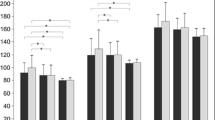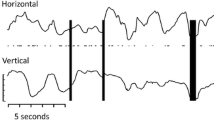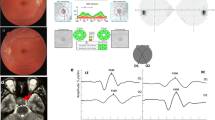Abstract
• Background: In Graves' disease the optic neuropathy (ON) is due to direct compression of the nerve and/or of its blood supply. The aim of the present study was to detect early changes in the visual functions of patients affected by ophthalmic Graves' disease (OGD) by using electrophysiological tests (P-VEP and PERG). • Methods: We studied 50 OGD patients who were in a range between class 2 and class 5 according to the Donaldson-American Thyroid Association classification, i.e. had no evident ON and normal visual acuity. We recorded transient reversal PERG and P-VEP in response to the stimulation of one eye at three spatial frequencies (2.2, 1.1 and 0.5 c/d). • Results: Our results showed a statistically significant reduction in PERG amplitude in class 5, while the P-VEP amplitude was already reduced in class 2. • Conclusion: The electrofunctional tests were useful to detect small changes in the visual function of patients affected by initial stages of OGD. Therefore, P-VEP and PERG recordings appear to be a useful tool for early diagnosis of the optic nerve involvement in Graves' disease.
Similar content being viewed by others
References
Adachi-Usami E (1990) Senescence of visual function as studied by visually evoked cortical potentials. Jpn J Ophthalmol 34:81–94
Bobak P, Friedman R, Brigell M, Goodwin J, Anderson R (1988) Visual evoked potentials to multiple temporal frequencies. Arch Ophthalmol 106:936–940
Burke W, Cottee LJ, Garvey J, Kumarasinghe R, Kriacou C (1986) Selective degeneration of optic nerve fibres in the cat produced by a pressure block. J Physiol 376:461–476
Coleman DJ, Dallow RL (1978) Ophthalmic ultrasonography, ocular ultrasonography, orbital ultrasonography. In: Duane FD (ed). Harper&Row, pp 25–27
Dallow RL, Momose KJ, Weber AL (1976) Comparison of ultrasonography, computerized tomography (EMI scan) and radiographic techniques in evaluation of exophthalmos. Trans Am Acad Ophthalmol Otolaryngol 81:305–322
Donaldson SS, Bagshaw MA, Kriss JP (1973) Supervoltage orbital radiotherapy for Graves' ophthalmopathy. J Clin Endocrinol Metab 37: 276–285
Esser J, Sobczynski H (1988) Therapiebegleitende Verlaufsbeobachtung der visuell evozierten kortikalen Potentiale bei Patienten mit endokriner Ophthalmopathie (Stadium 6). Fortschr Ophthalmol 85: 541–544
Gorman CA, Bahn RS (1989) Pathogenesis of Graves' ophthalmopathy. Dev Ophthalmol 20:1–7
Gorman CA, Waller RR, Dyer JA (1984) The eye and orbit in thyroid disease. Raven Press, New York
Holder GE, Condon JR (1989) Pattern visual evoked potentials and pattern electroretinograms in hypothyroidism. Doc Ophthalmol 73:127–131
Hufnagel TJ, Hickey WF, Cobbs WH, Jakobiec FA, Iwamoto T, Eagle RC (1984) Immunchistochemical and ultrastructural studies on the exenterated orbital tissue of a patient with Graves' disease. Ophthalmology 91:1411–1419
Kennerdell IS, Rosenbaum AE, El Hoshy MH (1981) Apical optic nerve compression of dysthyroid optic neuropathy on computed tomography. Arch Ophthalmol 99:807–809
Ladenson PW, Stakes JW, Ridgway EC (1984) Reversible alteration of the visual evoked potential in hypothyroidism. Am J Med 77:1010–3
Leone CR, Bajandas FJ (1981) Inferior orbital decompression for dysthyroid optic neuropathy. Ophthalmology 88:525–532
Maffei L, Fiorentini A (1981) Electroretinographic responses to alternating gratings before and after section of the optic nerve. Science 211: 953–955
Mastaglia FL, Black JL, Collins DWK, Gutteridge DH, Yeun RWM (1978) Slowing of conduction in visual pathway in hypothyroidism. Lancet i:387
Mitchell KW, Wood CM, Howe JW (1988) Pattern visual evoked potentials in hypothyroidism. Br J Ophthalmol 72:534–537
Neigel JM, Rottman J, Belkin RI (1988) Dysthyroid optic neuropathy. The crowded orbital apex syndrome. Ophthalmology 95:1515–1521
Pearlman JT, Burian HM (1964) Electroretinographic findings in thyroid dysfunction. Am J Ophthalmol 58:216–226
Spadea L, D'Amico M, Dragani T, Balestrazzi E (1994) Esami elettrofunzionali. Sintomi funzionali senza evidenze papillari. Proc. XV Corso APIMO 11 nervo ottico nella pratica clinica. Arbe, Modena, pp 63–72
Takahashi K, Fujitani Y (1970) Somatosensory and visual evoked potentials in hyperthyroidism. Electroencephalogr Clin Neurophysiol 29: 551–556
Trobe JD (1981) Optic nerve involvement in dysthyroidism. Ophthalmology 88:488–492
Van Ouerkerk BM, Wijngaarde R (1985) Radiotherapy of severe ophthalmic Graves' disease. J Endocrinol Invest 8: 241–247
Wijngaarde R, Van Lith GHM (1979) Pattern EPS in endocrine orbitopathy. Doc Ophthalmol 48: 327–332
Wirth A (1968) ERG and endocrine disorders. In: Francois J (ed) The clinical value of electroretinography. ISCERG Symposium, Ghent, 1966. Karger, Basel, pp 260–266
Author information
Authors and Affiliations
Rights and permissions
About this article
Cite this article
Spadea, L., Bianco, G., Dragani, T. et al. Early detection of P-VEP and PERG changes in opthalmic Graves' disease. Graefe's Arch Clin Exp Ophthalmol 235, 501–505 (1997). https://doi.org/10.1007/BF00947007
Received:
Revised:
Accepted:
Issue Date:
DOI: https://doi.org/10.1007/BF00947007




